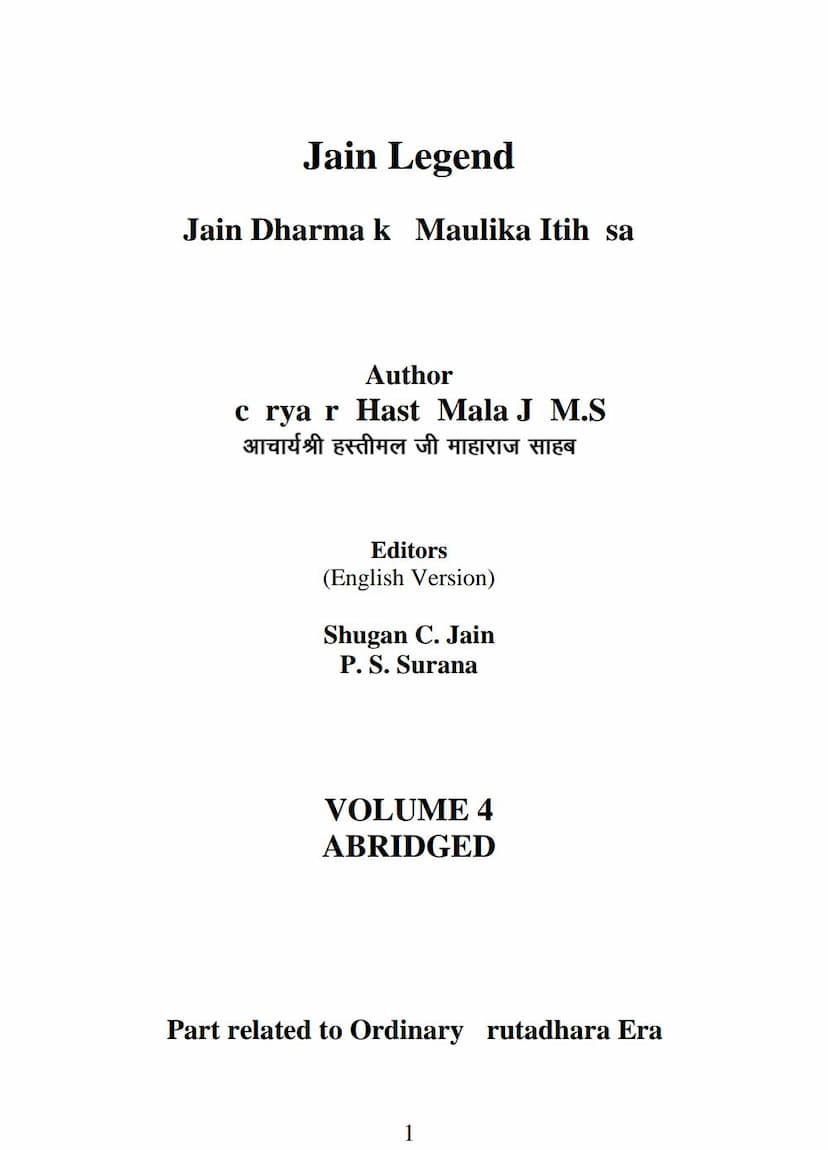Jain Legend Vol 4
Added to library: September 2, 2025

Summary
Here's a comprehensive summary of "Jain Legend Vol 4" based on the provided text, focusing on the historical narrative and key figures within the context of Jainism:
Jain Legend Vol 4: Abridged History of the Ordinary Yuga-dhara Era
This volume, the fourth in the "Jain Legend" series, is an abridged English translation of "Jain Dharma k Maulika Itih sa" (Abridged). It focuses on the historical trajectory of Jainism from Vira Nirvana (V.N.) 1476 to 2000, detailing the internal conflicts, scholarly contributions, and societal impact of the religion.
Key Themes and Content:
- Pontiffs and Epochal Acharyas: The book meticulously chronicles the lives and tenures of successive Jain pontiffs (the heads of the religious order) and epochal Acharyas (significant spiritual leaders who left a lasting impact). It provides birth, initiation, ordination, and death dates, along with brief summaries of their contributions.
- Internal Conflicts and Gacchas: A significant portion of the volume is dedicated to the internal disputes, rivalries, and the emergence of various gacchas (sects or sub-sects) within Jainism. It highlights the struggle between the "Temple Dweller" (Caityavās) tradition, characterized by more ritualistic and material-offering-based practices, and the "Suvihita" (well-ordered or scripture-based) tradition, which emphasized adherence to the original Jain tenets.
- Reformation Movements: The text details several reformation movements initiated by prominent Acharyas like Vardhamana Sri, Jinavallabha Sri, Jinadatta Sri, and Lokha. These movements aimed to re-establish the pure, scripture-based practices of Jainism, often in opposition to the perceived laxity and deviations within the Temple Dweller tradition and, at times, even within other Suvihita gacchas.
- Scholarly Contributions: The volume extensively discusses the literary and philosophical contributions of various Acharyas, particularly highlighting their commentaries (vṛttis) on Jain scriptures (āgamas). Acharyas like Abhayadeva Sri, Jinavallabha Sri, Malayagiri, and Hemacandra Sri are recognized for their monumental works that clarified complex Jain doctrines and preserved the tradition for future generations.
- Social and Political Context: The book interweaves the religious history with the prevailing social and political conditions of the time. It mentions significant political events, rulers, and invasions (e.g., Mahmud of Ghazni's invasions) that impacted the Jain community and their practices. It also touches upon the influence of royal patronage on the spread and sustenance of Jainism.
- Key Figures and Their Impact:
- Acharya Vardhamana Sri: Credited with initiating a religious revolution against the Temple Dweller tradition, leading to the formation of the Kharatara gaccha.
- Acharya Jinavallabha Sri: A prominent disciple and successor who continued the struggle against the Temple Dwellers, known for his scholarship and reforms.
- Acharya Abhayadeva Sri: Revered as "Navāṅga Vṛttikāra" for his extensive commentaries on nine aṅgas, he played a crucial role in clarifying Jain scriptures.
- Acharya Hemacandra Sri: Hailed as the "Omniscient of Kaliyuga," he was a prolific author, a wise advisor to kings like Siddharaja Jayasimha and Kumarpala, and a significant force in promoting Jainism and ethical conduct. His influence led to widespread adoption of Jain principles, including the prohibition of animal slaughter.
- Acharya Jinadatta Sri: A charismatic and influential Acharya known for his debates and prolific writings, who also significantly contributed to the Kharatara gaccha.
- Lokha: A later religious reformer who emphasized a return to scripture-based principles, non-violence, and detachment from material possessions, challenging the prevailing lax practices and establishing the Jinamat (later known as Lok gaccha). His movement is described as a "Renaissance" in Jainism.
- King Kumarpala: A significant royal patron of Jainism, deeply influenced by Acharya Hemacandra Sri, who implemented major reforms, including the prohibition of animal slaughter, and constructed numerous monasteries, earning the title "Paramarhaṭa" (Supreme Devotee).
- Internal Debates and Divergences: The text highlights the intellectual debates and divergences of opinion among different gacchas regarding interpretations of scriptures, rituals, and the very definition of authentic Jain practice. These debates sometimes led to animosity and attempts to discredit opposing traditions.
- Decline and Survival of Jainism: The volume touches upon periods of decline and persecution faced by Jainism, particularly in South India due to invasions and the rise of other religious movements. It also underscores the resilience of the faith, with dedicated Acharyas and followers working to preserve its core principles.
- Chronological Conversion of Years: The book provides a helpful guide for converting various calendar systems (Vira Nirvana, Vikram, Christian, Hijri) to facilitate historical understanding.
Overall Significance:
"Jain Legend Vol 4" serves as a detailed historical account of a crucial period in Jainism. It showcases the dynamic interplay of spiritual leadership, scholarly endeavor, social reform, and political circumstances that shaped the religion. The volume emphasizes the continuous struggle to maintain the purity of Jain doctrine amidst changing times and the unwavering commitment of numerous Acharyas to uphold the eternal truths of Lord Mahavira's teachings. It highlights the importance of adhering to scriptures while also acknowledging the evolution and adaptation within the Jain tradition through various reformation movements.